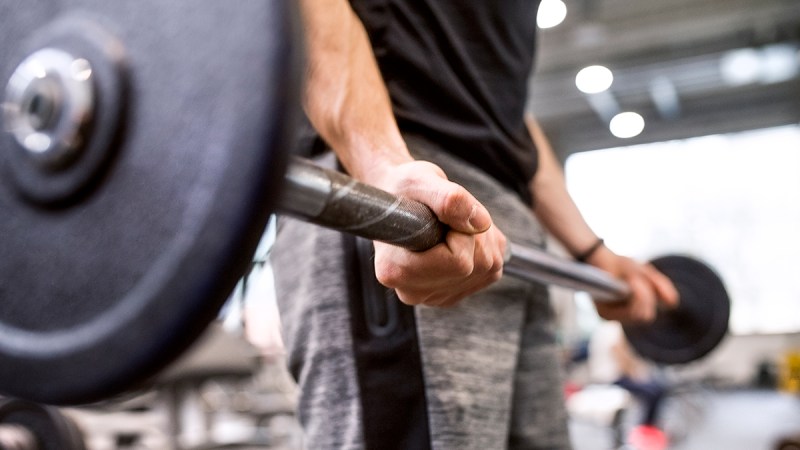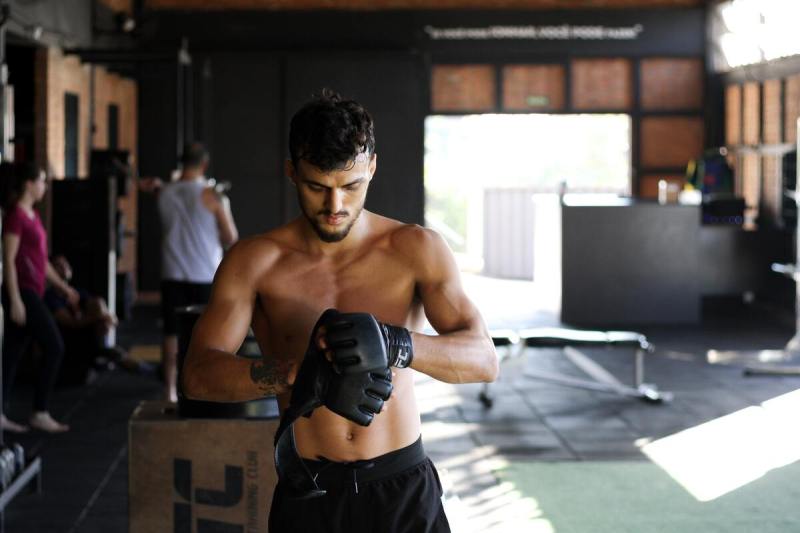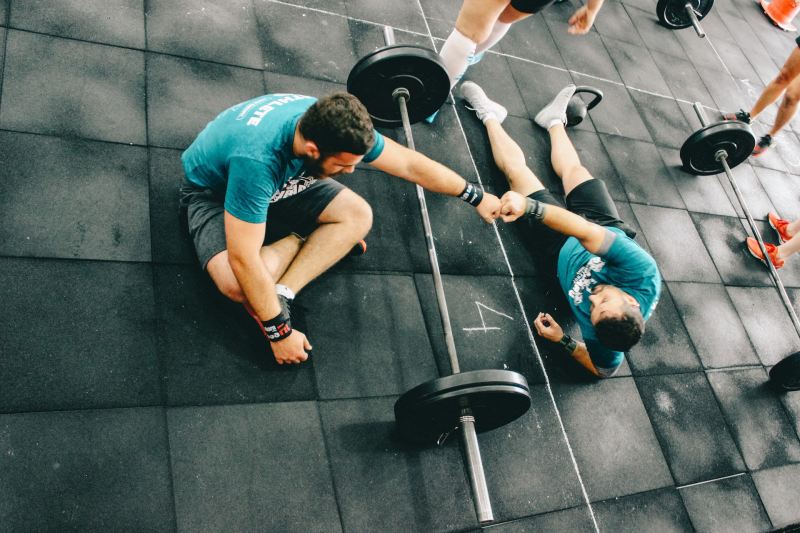Upper body workouts play a significant role in building strength. Adding barbell workouts will also improve your athletic performance in highly effective and efficient ways. In this article, we explore eight barbell exercises specifically designed to build upper-body muscle mass and strength.
These exercises engage a wide range of muscles, including the chest, shoulders, triceps, back, and biceps. Regardless of whether you’re an experienced weightlifter or an enthusiastic beginner, you can explore and enjoy these best upper body barbell workouts to build a stronger, more muscular upper body with only a barbell.
8 upper body barbell workouts

1. Bench press
The bench press exercise with barbells is an upper-body pressing movement that builds muscle size and body strength. It does this by targeting upper body muscles like the chest, triceps, and shoulders. If you want to build strength and increase body size, this is the exercise for you.
Because it requires you to lie flat on a bench, your muscles remain stable while giving you the ability to lift a heavier amount of weight. This is how it leads to greater muscle development.
Instructions:
- Lie on your back on a bench.
- Grab a barbell with an overhand grip. Make sure your hands are just wider than shoulder-width apart. Hold it above your chest with your arms fully extended.
- Bend your elbows and slowly lower the bar to your chest in a controlled motion. Keep your elbows close to your body.
- Press the bar in a straight line back up to return to the starting position.
- Repeat six to ten times.
2. Military press
The military press boosts upper body strength. It also improves the range of motion in your elbows.
Instructions:
- Grip a barbell with your palms facing forward. Make sure your grasp is wider than your shoulder’s width. Hold the barbell at chest level.
- Slightly bend your knees, and position your feet about shoulder-width apart from each other.
- Brace your core and push the bar over your head. Fully extend and lock your arms.
- Breathe in as you slowly lower the bar back down to your collarbone.
- Breathe out as you lift the bar back up.
- Repeat eight to 12 times.
3. Overhead tricep extension
The overhead triceps extension with barbells is an isolation exercise. It’s usually performed for middle to high reps as part of a plan focusing on the arms. If holding a straight bar puts stress on your wrists or elbows, perform it instead with an EZ or neutral-grip bar.
Instructions:
- Stand with a barbell held over your head with both hands. Make sure your hands almost touch and face your palms forward.
- Bend your elbows and slowly lower the bar behind your head. Keep your upper arms stationary.
- Pause when your elbows get to 90 degrees, and then flex your triceps to return to the starting position.
- Repeat 12 to 15 times.
4. Barbell curls
When doing barbell curls, avoid swinging your body back when moving the weight up. This doesn’t allow you to fully experience the benefit of this exercise. Instead, keep your body fixed and only utilize your biceps to move the weight.
Another error that beginners may make is not keeping their elbows fixed and tucked into their sides. Do not allow your elbows to move forward when getting that weight up. You also want to move slowly and deliberately.
Instructions:
- Grasp a barbell with hands around shoulder-width apart. Use the underhand grip with your palms facing up, and stand straight.
- Keep your feet together, or move one foot back for stability. Make sure your back is straight.
- Fully extend your arms, and tuck your elbows in at the sides.
- Slowly curl the bar up toward your shoulders.
- Pause for a moment at the top before gradually releasing the bar back down to the starting position.
- Repeat ten to 15 times.
5. Front raises
This popular exercise builds up the front deltoid muscles. Front raises also target the smaller muscles such as traps, forearms, and core. Use an Olympic barbell or standard fixed-weight barbell when doing this workout.
You can also do this as a beginner, intermediate, or advanced lifter using upper body strength to complete the lateral movement.
Instructions:
- Grab a barbell from the rack or floor with a pronated grip. Keep your hands shoulder-width apart.
- Breathe in, and engage your core, glutes, and shoulders.
- Keep your arms straight as you lift the barbell up and out in front of you.
- Pause when your arms are parallel to the floor.
- Slowly lower it back to the starting position.
- Repeat ten to 12 times.
6. Forearm curls
Forearm curls don’t require a lot of movement, but the effects can still be substantial. Do not hyperextend your wrists and instead keep some tension present by not allowing your wrists to relax. Be sure to stretch them during the proper warm-up routine before starting this exercise.
In general, forearm exercises pose the threat of wrist strains or sprains. Help yourself avoid this by using proper form and lighter weights until you’re more experienced and comfortable with this movement.
Instructions:
- Sit on a flat bench. Lean forward, and grip the barbell with your palms facing up.
- Rest your forearms on either the bench or your thighs.
- Curl the weight upward with only your wrists.
- Slowly lower the weight. Go as low as you can, comfortably.
- Repeat 12 to 15 times.
7. Preacher curls
When doing preacher curls, pause at the bottom instead of after the lift. Keeping the motion slow and controlled, without stopping, will isolate the biceps. It also helps you achieve a fuller range of motion and to get the most out of this exercise.
Instructions:
- Adjust the preacher bench seat so that you sit with your upper arms resting comfortably on the padding. Load your desired weight.
- Grasp the barbell with your hands shoulder-width apart. Use an underhanded grip with your palms facing up. Keep your back straight, and make sure your eyes face forwards.
- Take the weight off the rack and keep your arms slightly bent.
- Raise the weight slowly until your forearms are at a right angle. Engage your bicep at the top.
- Slowly lower the barbell back to the starting position.
- Repeat eight to 12 times.
8. Barbell rows
Barbell rows work your upper and lower back as well as hips and arms. This full-body, compound exercise builds a stronger, more muscular back and bigger biceps.
Keep your lower back neutral to avoid any discomfort. Letting it round may unintentionally squeeze your spinal discs. Be sure to rest the bar on the floor between reps and set your lower back neutral each time.
Instructions:
- Stand in a medium stance with your midfoot under the bar.
- Bend over and grab the bar. Keep your palms down in a medium grip. Hinge forward slightly at the hips while keeping your back straight, chest up, and shoulders back.
- Bend your elbows to pull the bar up to your lower chest.
- Straighten your arms before repeating the movement.
- Repeat ten to 15 times.
Anatomy of the upper body

The upper body anatomy involves every body part above the waist. This includes the head, neck, shoulders, stomach, back, and chest. The arm, consisting of the upper arm, forearm, and hand, is also part of the upper body and should be frequently strengthened for increased ease with daily functional tasks.
What are the benefits of training with a barbell?

Easy to use
Barbells are easy to use. Beginners catch on quickly and easily develop a training routine that includes basic lifts. They are fantastic tools for every level of fitness.
Versatile
Barbells can be used in so many different ways with a variety of movements. Don’t confine them to one type of exercise or body part. You’ll save time because they minimize your need to switch from machine to machine.
Adaptable
No matter what exercise you choose, barbells allow you to slowly increase or decrease weight as you go along. Simply adding weight gives you plenty of room to progress.
They’re also more convenient than using weighted machines. Progressing with barbells usually involves the barbell itself, some weight plates, and collars. It’s simple.




